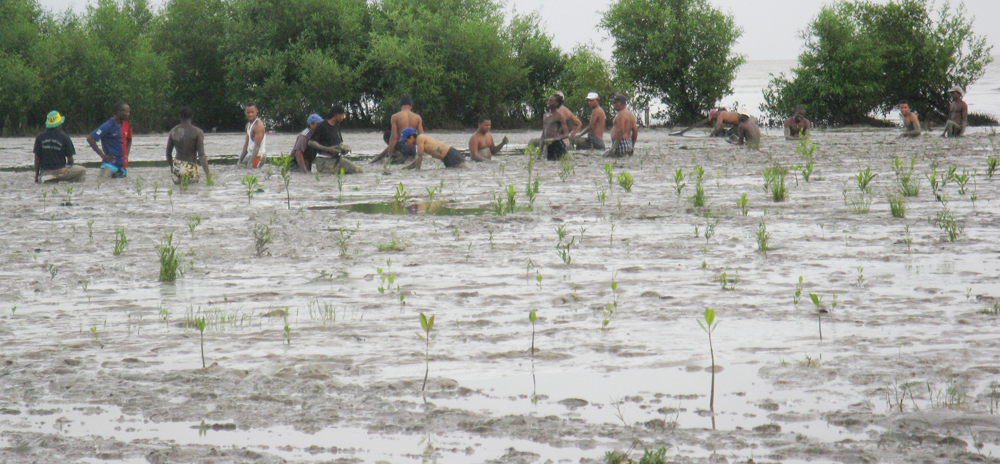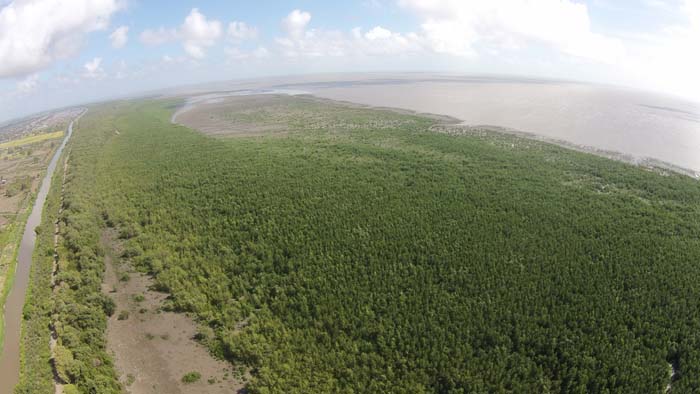A very important plant species well known across the coastal plains of Guyana is called mangrove. Mangroves are a group of trees and shrub which grow in area with low-oxygen soil, whereby slow-moving waters allow fine sediments to accumulate.
Origin of the term
The term “mangrove” comes to English from Spanish (perhaps by way of Portuguese), and is likely to originate from Guarani. It was earlier “mangrow” (from Portuguese mangue or Spanish mangle), but this word was corrupted via folk etymology influence of the word “grove”.
Scientific Classification
The word ‘Mangroves” refers to a group of plants which may actually belong to several families (species that distinctly belong to their own evolutionary group). The term therefore indicates an ecological rather than a taxonomical (scientific classification) grouping – the species are not related. They are unique plants because of their ability to grow in unstable tough environments.
About Mangroves In Guyana
Mangroves cover about 290 km of Guyana’s 430 km coast, and line many of our rivers. They are unique plant species as they can survive under harsh conditions, such as water poor in oxygen, salt water, and brackish water (a mixture of salt and fresh water).
Mangroves are fast growers and reach up to 25m. Worldwide, mangroves cover approximately 172,000 km2 of the earth’s surface. However, about 35% of this was lost during the last several decades. The quantity of mangrove forests in Guyana has also been declining. Many mangrove forests can be recognized by their dense tangle of prop roots that make the trees appear to be standing on stilts above the water. This tangle of roots allows the trees to handle the daily rise and fall of tides, which means that most mangroves get flooded at least twice per day. Mangrove forests stabilize the coastline, reducing erosion from storm surges, currents, waves, and tides. The intricate root system of mangroves also makes these forests attractive to fish and other organisms seeking food and shelter from predators.
Types of Mangroves
In all, there are seven species of mangroves. Three of these (the red, black and white mangroves) are found in Guyana.
Red Mangrove (Rhizophora mangle)
The red mangrove is easily recognised by its exposed prop and aerial root system which stabilises the tree, and also by the long seedlings (propagules) that hang from the branches. They are commonly found along inland rivers.
Black Mangrove (Avicennia germinans)
Also known as Courida, this type inhabits Guyana’s coastline, which is washed by the Atlantic Ocean. It is not usually found along river banks. Black mangroves, like red mangroves, are easily identified by their roots. However, it is not the exposed prop roots that make the black mangroves stand out. Instead it is the numerous breathing tubes, called pneumatophores, which stick vertically out of the ground. These pneumatophores trap oxygen for the plant.
White Mangrove (Laguncularia racemosa)
White mangrove grows shorter than the red or black mangroves and is found in the back portion of the mangrove forest. The white mangrove’s leaves have special openings/glands which allow salt to pass from inside the plant to the outside. This causes a coating of white salt crystals to remain on the leaves, hence the name white mangrove.
Importance of Mangroves

Some of the volunteers assisting in the planting of Mangroves at Hope Beach | KNews Image
Both the environment and its people receive benefits from mangrove forests and its variety of services. These include that they:
- Trap and cycle various organic materials, chemical elements, and important nutrients in the coastal ecosystem.
- Provide food for marine organisms.
- Provide physical habitat and nursery grounds for a wide variety of marine organisms, such as fish, shrimp and crabs.
- Serve as roosting and nesting sites for many of our birds.
- Serve as storm buffers by reducing wind and wave action in shallow shoreline areas.
- Assist in protecting water quality and clarity by filtering runoff and trapping sediments and debris from adjacent uplands.
Mangroves are vital!
Most importantly mangroves are sea defence structures. They break the force of waves and reduce erosion. Without these mangroves most of Guyana’s coastline would have been severely eroded leading to bank collapse and increased flooding. Ecologically fishes, shrimp, crabs and other organisms would lose their habitat and their numbers would decrease. Since it is these same organisms which we harvest for food, fewer organisms would mean less food for us.
Features
The common mangrove grows to about 9 metres (30 feet) tall. The leaves are 5 to 15 cm (2 to 6 inches) long, opposite, oval or elliptic, and smooth-edged; they are thick, have leathery surfaces, and are borne on short stems. The flowers are pale yellow. While the fruit is still attached to the parent branch, the long embryonic root emerges from the seed and grows rapidly in a downward position. When this propagule falls, the young root is in the correct position to be driven into the mud; the plant being thus rooted, the shoot makes its appearance.
Threats and conservation status of mangroves
In recent decades the mangrove belt has been severely depleted as the natural cycle of erosion and accretion lost equilibrium. Although the precise mechanisms for this are poorly understood, heavy damage by human use, rise in sea level and increased wave force appear to be the main reasons.
The mangrove forest that once covered our entire coast has been drastically depleted, and in many instances lost altogether. Additionally, mangrove habitats in Guyana such as river mouths and estuaries, are also near where the population is located. The Guyana Forestry Commission (GFC) is preparing a Code of Practice for mangrove vegetation in order to better manage the mangrove forests of Guyana’s coastal area.
Mangroves have been declared a protected species in Guyana and there is a fine for illegal cutting of mangroves.
Some specific threats that affect mangroves include:
- Accidental fires
- Indiscriminate hunting of wildlife (either for commercial or recreation)
- Grazing of animals
- Pulling boats indiscriminately through mangrove areas
- Harvesting of seashells which contributes to erosion and degrades the shoreline.
- Pollution from dumping of garbage. Although the mangroves serve to trap and prevent litter from reaching inland, indiscriminate dumping creates an unhealthy environment for the ecosystem and for people.
- In other countries, overuse of areas for setting up fish and shrimp ponds has contributed significantly to loss of mangroves.
Providing a better life for the population while protecting the future and the environment must sometimes seem like a delicate balancing act on a tightrope for the country; nevertheless equitable methods of dealing with both have to be sought.
Article References
- https://oceanservice.noaa.gov/facts/mangroves.html
- http://guyanachronicle.com/2015/08/15/mangroves
- http://www.mangrovesgy.org







